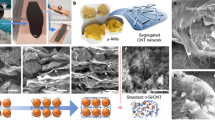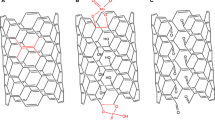Abstract
Carbon nanotubes including arc multi-walled nanotubes (arc-MWNT), arc- and laser-produced single-walled nanotubes (SWNT), and catalytically grown multi-walled nanotubes (vapor grown, VG, and chemical vapor deposited, CVD MWNT) were investigated as anode materials for lithium ion intercalation and de-intercalation. As-produced arc-MWNT deliver capacity in the range of 190–210 mAh/g and an irreversible capacity in the range of 90 to 140 mAh/g. The reversible capacity improved to 310–340 mAh/g with purification and opening of the ends of the tubes. SWNT delivered relatively high reversible capacity of over 600 mAh/g but they were associated with very high irreversible capacity (∼200%) that makes these materials impractical to use as an anode material for lithium batteries. VG nanofibers exhibited poor reversible capacity and also very high irreversible capacity. On the other hand, CVD MWNT delivered over 400 mAh/g reversible capacity with relatively low irreversible capacity (<25%). Further work will be needed to optimize these promising materials.
Access this chapter
Tax calculation will be finalised at checkout
Purchases are for personal use only
Preview
Unable to display preview. Download preview PDF.
Similar content being viewed by others
References
Y. Nishi, Power’ 95, Santa Clara, CA, October 1995.
B. M. Way and J. R. Dahn, ‘Boron Substituted Carbon as a Anodes for Lithium Ion Cells’, Extended Abstract, V. 93-2, p. 34, Electrochem. Society, Spring Meeting, New Orleans, October 1993.
R. Yazami (private communication).
R. O. Loutfy, T. P. Lowe, A. P. Moravsky and S. Katagiri, ‘Commercial Production of Fullerenes and Carbon Nanotubes’, this volume, 35–46.
R. O. Loutfy, A. Moravsky, A. Franco and E. Veksler, ‘Physical Hydrogen Storage on Nanotubes and Nanocarbon Materials’, this volume, 327–339.
Author information
Authors and Affiliations
Editor information
Editors and Affiliations
Rights and permissions
Copyright information
© 2002 Kluwer Academic Publishers
About this chapter
Cite this chapter
Loutfy, R.O., Hossain, S., Moravsky, A., Saleh, M. (2002). Nanotubes as Anode Material for Lithium-ion Batteries. In: Ōsawa, E. (eds) Perspectives of Fullerene Nanotechnology. Springer, Dordrecht. https://doi.org/10.1007/0-306-47621-5_31
Download citation
DOI: https://doi.org/10.1007/0-306-47621-5_31
Publisher Name: Springer, Dordrecht
Print ISBN: 978-0-7923-7174-8
Online ISBN: 978-0-306-47621-1
eBook Packages: Springer Book Archive




